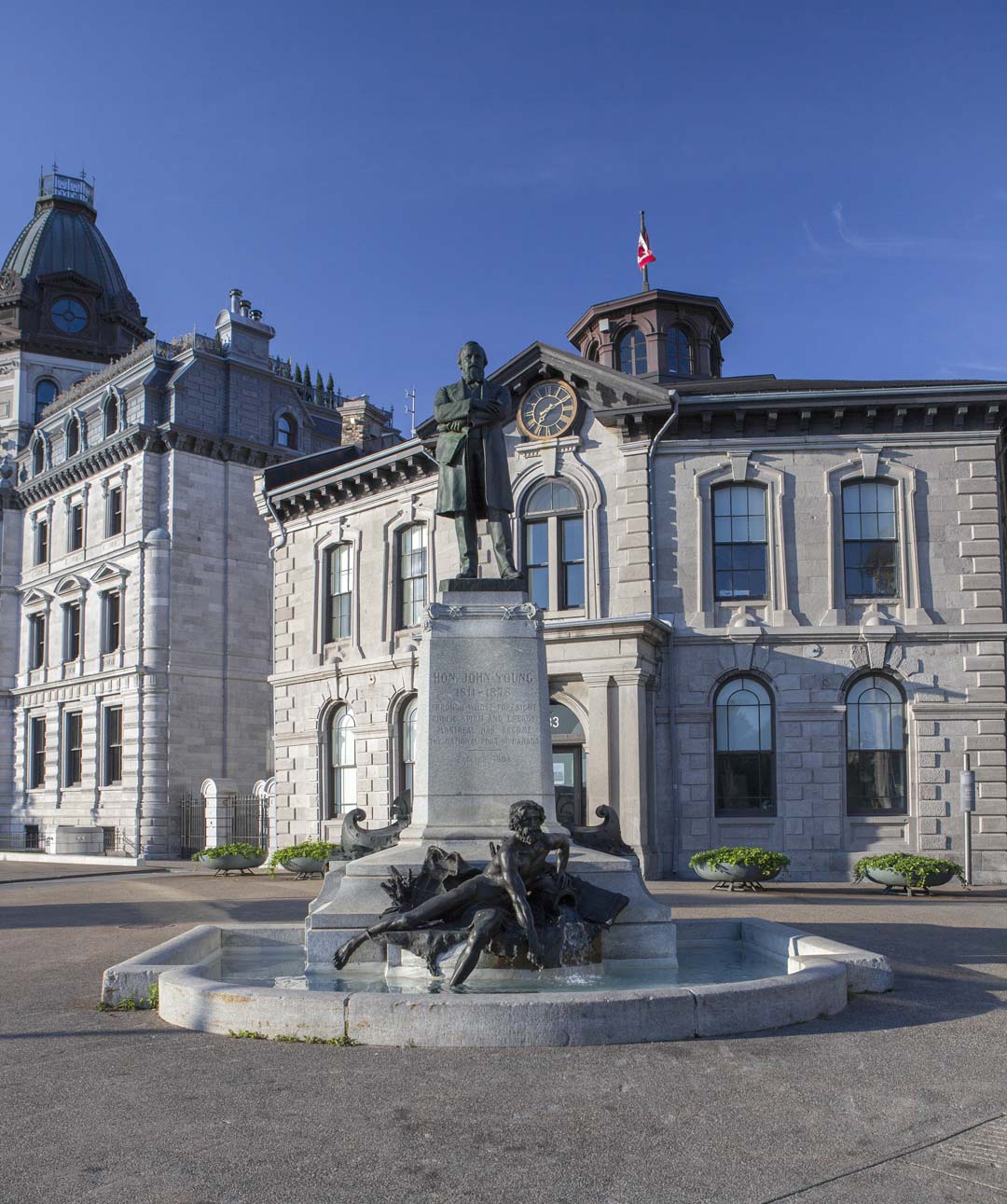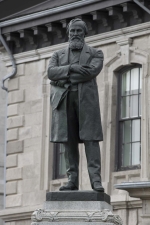Louis-Philippe Hébert
Monument à John Young
1911
Presentation of the artwork
This monument-fountain is composed of four bronze elements on a granite pedestal placed in the centre of a grey-granite basin. At the base is the allegorical figure of the River God who, reclining on the debris of a shipwreck, holds a bowl from which the fountain’s water flows. The statue of John Young is at the top of the pedestal. Young is portrayed standing, his arms crossed, holding documents in one hand and wearing a redingote, in the style of the era. On either side of the pedestal, two ship’s prows emerging from the waves, referring to navigation on the St. Lawrence, complete the composition. The relationship established between the main character and the secondary figure are based on a balance between realism – John Young – and symbolism – the figure representing the river.The artwork has been moved twice; originally situated in Place Royale, it was moved to Pointe-à-Callière in 1952, before being installed permanently in its current site, in front of the offices of the Société du Vieux-Port de Montréal, in 1997. Because the artwork pays tribute to a president of the Montréal Harbour Commission, who oversaw the improvement and development of the port facilities, its siting has always privileged a close connection between the person, the river, and the port of Montréal.
When Louis-Philippe Hébert began to work on this commission, he was 56 years old and at the height of his fame. This artwork shows his artistic maturity, notably through the portrayal of the River God, which may be considered one of his freest and most inspired pieces.
Associated events
The 100th anniversary of the birth of John Young provided the government of Canada and the administrators of the Montréal Harbour Commission with an opportunity to commemorate Young’s major role in development of the city’s port. John Young (11 March 1811, Scotland – 12 April 1878, Montréal) moved to Montréal in 1830. He worked in various capacities: importer, exporter, founder of a number of railway and telegraph companies, representative for Montréal at the Assembly of United Canada, and commissioner and president of the harbour.
Louis-Philippe Hébert
Louis-Philippe Hébert (27 January 1850, Sainte-Sophie-d’Halifax, Québec – 13 June 1917, Westmount, Québec) received training in the Quebec tradition of sculpting in wood passed down from the eighteenth century. He quickly turned toward the complex techniques of bronze casting that he discovered during his frequent visits to Paris. An elegant and conscientious artist, Hébert was able to assimilate the essentials of this method. With his majestic artworks, he marked a fundamental step forward in the art of sculpting in Québec, which also brought the province across the threshold of modernity.
Awards and honours
- Chevalier de Saint-Michel et de Saint-Georges, 1903
- Chevalier de la Légion d'honneur, 1901
- Médaille de la Confédération, 1894
- membre de la Royal Canadian Academy of Arts, 1880
Presentation of the artwork
This monument-fountain is composed of four bronze elements on a granite pedestal placed in the centre of a grey-granite basin. At the base is the allegorical figure of the River God who, reclining on the debris of a shipwreck, holds a bowl from which the fountain’s water flows. The statue of John Young is at the top of the pedestal. Young is portrayed standing, his arms crossed, holding documents in one hand and wearing a redingote, in the style of the era. On either side of the pedestal, two ship’s prows emerging from the waves, referring to navigation on the St. Lawrence, complete the composition. The relationship established between the main character and the secondary figure are based on a balance between realism – John Young – and symbolism – the figure representing the river.The artwork has been moved twice; originally situated in Place Royale, it was moved to Pointe-à-Callière in 1952, before being installed permanently in its current site, in front of the offices of the Société du Vieux-Port de Montréal, in 1997. Because the artwork pays tribute to a president of the Montréal Harbour Commission, who oversaw the improvement and development of the port facilities, its siting has always privileged a close connection between the person, the river, and the port of Montréal.
When Louis-Philippe Hébert began to work on this commission, he was 56 years old and at the height of his fame. This artwork shows his artistic maturity, notably through the portrayal of the River God, which may be considered one of his freest and most inspired pieces.
Associated events
The 100th anniversary of the birth of John Young provided the government of Canada and the administrators of the Montréal Harbour Commission with an opportunity to commemorate Young’s major role in development of the city’s port. John Young (11 March 1811, Scotland – 12 April 1878, Montréal) moved to Montréal in 1830. He worked in various capacities: importer, exporter, founder of a number of railway and telegraph companies, representative for Montréal at the Assembly of United Canada, and commissioner and president of the harbour.
Louis-Philippe Hébert
Louis-Philippe Hébert (27 January 1850, Sainte-Sophie-d’Halifax, Québec – 13 June 1917, Westmount, Québec) received training in the Quebec tradition of sculpting in wood passed down from the eighteenth century. He quickly turned toward the complex techniques of bronze casting that he discovered during his frequent visits to Paris. An elegant and conscientious artist, Hébert was able to assimilate the essentials of this method. With his majestic artworks, he marked a fundamental step forward in the art of sculpting in Québec, which also brought the province across the threshold of modernity.
Awards and honours
- Chevalier de Saint-Michel et de Saint-Georges, 1903
- Chevalier de la Légion d'honneur, 1901
- Médaille de la Confédération, 1894
- membre de la Royal Canadian Academy of Arts, 1880






